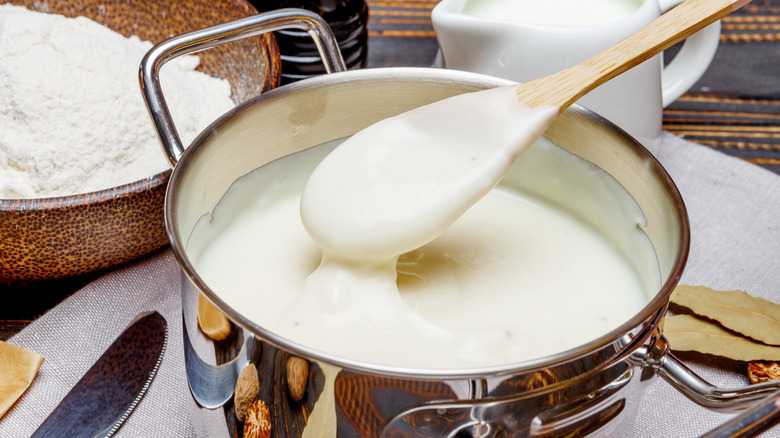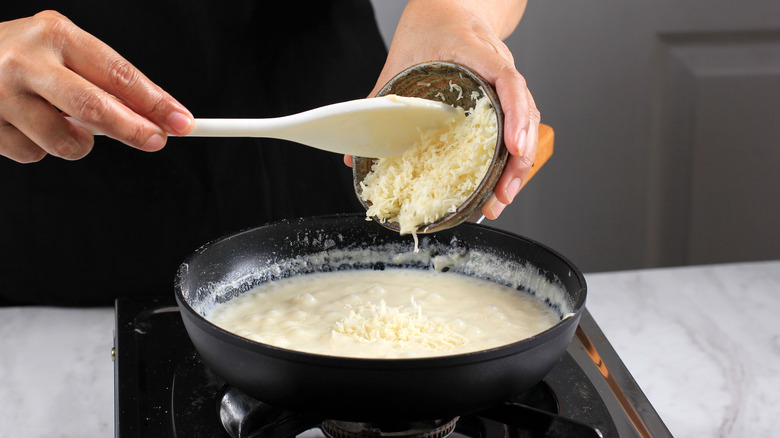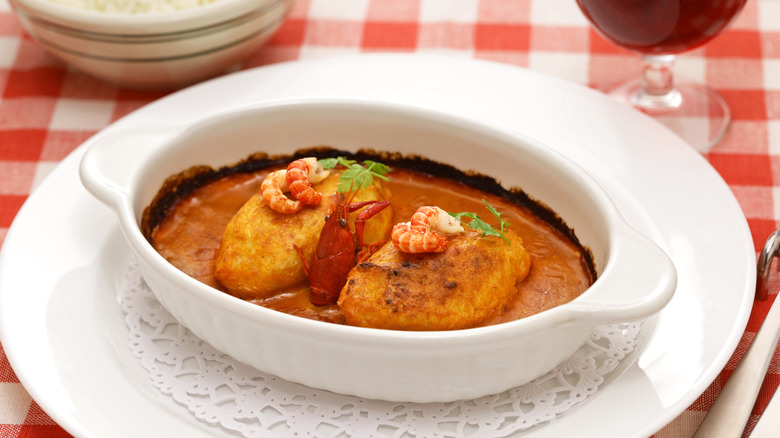What Makes Mornay Sauce Different From Béchamel?
Although you may not know it by name, chances are you've enjoyed Mornay sauce at some point. It's used in mac and cheese; the brunch dish eggs Florentine, a spinach-rich alternative to eggs Benedict; and much more. This condiment starts actually starts with a simple béchamel, another versatile French sauce, but one key addition differentiates it: cheese.
Béchamel, aka white sauce, is one of five mother sauces in French cuisine, with the others being hollandaise, velouté, Espagnole, and tomato. They're called "mother sauces" because many other sauces can be produced from these simple bases, just by adding extra ingredients or flavorings. A basic béchamel is made with only butter, milk, and flour. The process involves making a white roux by cooking together the flour and butter to create a paste, then whisking in warm milk until the sauce reaches a creamy consistency.
Béchamel is also sometimes simmered with aromatics such as onion, cloves, bay leaf, and nutmeg. To create Mornay from a béchamel sauce, you just need to add shredded cheese, which melts into the liquid to create a silky, cheesy sauce that's packed with flavor. For the best results, though, you need to pay close attention to technique and the kind of cheese you use.
Use the right cheese and cooking temperature for successful Mornay
The choice of cheese in Mornay is important, as you need something that melts well as well while adding a luxuriously rich flavor. The most traditional options are Swiss cheeses such as Emmental or Gruyère, although cheddar also does a decent job and is a popular choice for the best homemade mac and cheese.
When adding the cheese to the béchamel, it's essential to keep the heat low to prevent the sauce from splitting. Add the cheese in two or three batches, letting each one melt almost completely before whisking in the next part. If the sauce is too thick, you can always loosen it with a little extra milk. If you want to make Mornay sauce ahead of time, it will keep in the refrigerator for several days in an airtight container; just reheat it gently when you're ready to serve it, or it might break.
In classic French cuisine, Mornay is often enriched further by adding an egg yolk or two to. The velvety sauce is commonly poured over fish, shellfish, vegetable, or poached egg dishes, which can be finished under the broiler or in the oven until the cheesy topping turns golden-brown. Mornay is equally delicious served alongside chicken, fish, or vegetables.
Other sauces you can make from a béchamel
Béchamel can be used as a base for many sauces besides Mornay. The simplest is probably cream sauce, or sauce crème in French. As you've probably guessed, this one simply involves whisking heavy cream into béchamel, along with seasonings or a splash of dry white wine. Try it with pasta, turkey, or shrimp, or in a casserole.
For something more intensely savory, the onion-laden sauce known as soubise is a real treat. In famed French chef Auguste Escoffier's original version, onions are cooked until soft, but not browned, then simmered with béchamel sauce (though some modern recipes replace the béchamel with cream). The mixture is then puréed to create a smooth, flavorful sauce that goes wonderfully with meats such as chicken, pork, or steak, as well as vegetables. Or, try making an oniony homemade mac and cheese with soubise.
If you love seafood, then Nantua sauce is a must-try. Named after the region from which it originates, Nantua is made by combining béchamel with cream and crayfish butter or crayfish tails, though it can also be made with shrimp. Try serving this sauce with fish or seafood for an elegant dinner party dish.



